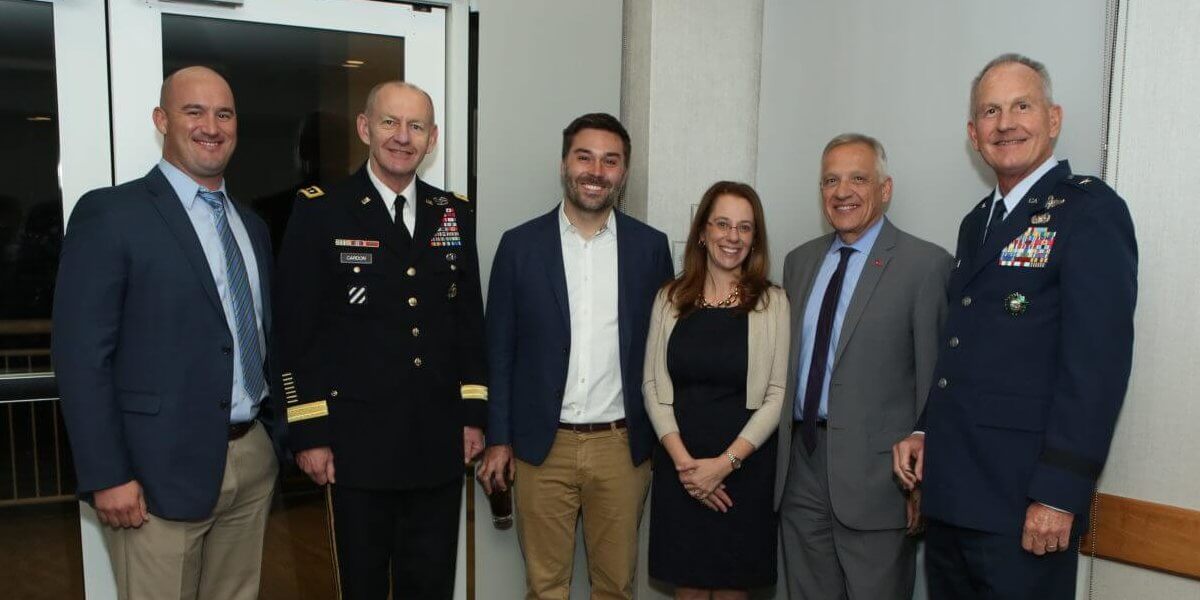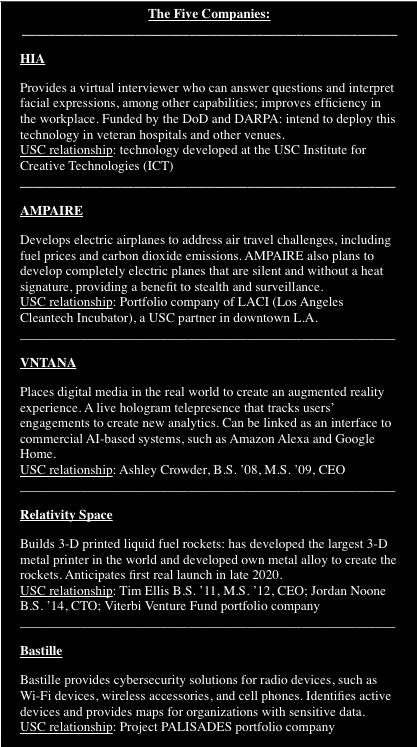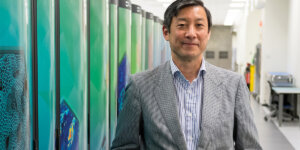
Dean Yannis Yortsos and Vice Dean Andrea Belz pictured with “Real Deal” attendees (Photo/Nicolas Sage)
Five rapidly growing companies pitched their business models on Nov. 30 to a room of senior military officers and investors, including Gen. (ret.) David Petraeus, at this fall’s “Real Deal @ USC” at the Marina Del Rey Hotel.
“This is a wonderful opportunity for us to highlight all the interesting things we do here at USC in the area of innovation and commercialization,” said Yannis Yortsos, dean of the USC Viterbi School of Engineering and host of the event.
The “Real Deal @ USC” fosters connections between entrepreneurs, investors, and other stakeholders who can accelerate commercialization of novel technologies with multiple applications.
Petraeus, a Judge Widney Professor collaborating with USC Viterbi, further emphasized USC’s vanguard role in Silicon Beach.
“This is part of an effort to build not only the USC ecosystem, but also to add to the success in building Silicon Beach as a rival to and partner of Silicon Valley,” Petraeus said.
The companies
The five ventures featured in the event were so-called “dual-use,” with applications for both the civilian and military markets. Companies were selected based on their ability to simultaneously address problems of national security and scalable commercial opportunities, according to the event page at the USC Viterbi Office of Technology Innovation and Entrepreneurship.
 One example was VNTANA, founded by USC Viterbi alumna Ashley Crowder, M.S. ’08 in engineering management. VNTANA offers proprietary augmented reality technology that projects holographic images capable of interacting with people nearby. One example is how semiconductor giant Intel used the technology in a test presentation in Taiwan; using VNTANA’s holographic telepresence, an Intel representative introduced a new test chip in person– without actually being in the room.
One example was VNTANA, founded by USC Viterbi alumna Ashley Crowder, M.S. ’08 in engineering management. VNTANA offers proprietary augmented reality technology that projects holographic images capable of interacting with people nearby. One example is how semiconductor giant Intel used the technology in a test presentation in Taiwan; using VNTANA’s holographic telepresence, an Intel representative introduced a new test chip in person– without actually being in the room.
However, this company offers more value than just remote sales presentations or even military training; VNTANA’s technologies have important implications for aerospace manufacturing.
“Using our interactive software and projection technology, it is possible to better visualize final parts during the manufacturing process to save on material costs and produce more accurate parts,” Crowder said. “Accuracy of composite parts is extremely important in aerospace engineering because of many factors, such as thermal protection systems.”
VNTANA’s commercial success also includes participation in this year’s San Diego Comic-Con (SDCC) with eight holographic projections, impressing Disney and ABC and prompting both to sign on as clients. Other notable clients include CISCO, Intel, and Lexus, Crowder said.
This was the fourth “Real Deal” event, but the first since the launch of USC Viterbi’s new Project PALISADES (Promote, Accelerate, Launch Innovation in Security, Aerospace, and DEfense Sectors), focusing on connecting the aerospace and defense sectors to the innovation community. One of the main partners of Project PALISADES, and a major sponsor of the Real Deal, was MD5, the National Security Technology Accelerator developed by the US Department of Defense. MD5 is a national organization whose goal is to “catalyze the creation of early stage ventures and national interest,” said founder Jay Harrison. MD5 incubates dual-use ventures and offers entrepreneurs assets to improve their research and commercialization capabilities. “Venture capitalists tend not to want to invest in infrastructure,” MD5’s Harrison said. “To the extent that startups are doing things relevant to national security, we want to make our infrastructure and assets available to the startup community.”
A major success story of the USC-MD5 partnership is Relativity Space, co-founded by two USC Viterbi alums: Tim Ellis, B.S. AME ’12, M.S. AME ’13; and Jordan Noone, B.S. AME ’14. Relativity Space is a launch vehicle company for sending satellites to space. Its goal? Using 3-D printing technologies and proprietary alloys, they will generate entire rockets. Automating rocket manufacturing would result in comparatively low-cost, high-performance spacecraft operational much faster than today’s rockets – Ellis estimates 60 days, in contrast to the 12 to 18 months it currently takes. And the efficiency doesn’t end there.
“This is software-defined automation,” Ellis said. “By controlling the building process with our software, we’re also able to collect data across the entire manufacturing process, which will help with quality assurance and mission success rate.”
In July 2016, Relativity Space had built the largest metal 3-D printer in the world: it can currently print rocket parts 10 feet in diameter and 20 feet tall. To date, the company has printed a full-scale fuel tank for a rocket’s upper stage. Relativity Space has already signed a billion dollars in launch use and anticipates its first real launch to occur sometime in late 2020.
Following company presentations, Andrea Belz, USC Viterbi vice dean of technology innovation and entrepreneurship and the Director of the National Science Foundation (NSF) Innovation Corps (I-Corps) Node based at USC, moderated an Oceanside Chat featuring panelists Gen. Petraeus; Lieutenant General Edward Cardon; and Trae Stephens, Partner at Founders Fund. They discussed various issues, including the importance of innovation policy on a national scale; modernizing the US military by importing elements of the Silicon Valley and Silicon Beach cultures; attracting problem-solving talent to government; and restoring the close alignment of innovation and defense.
Belz organized this year’s “Real Deal.” In her opening remarks, she underscored the importance of university-funded research. Belz quoted Congressional testimony stating that 30 percent of NASDAQ’s market value stemmed originally from university-funded research. Because the half of university research is sponsored by the US Defense Department, the aerospace and security world plays a key role in creating economic value on a national scale by developing transformational technologies underlying new ventures. The NSF I-Corps program provides a framework to link the defense and innovation communities.
“University entrepreneurship has four main roles: to teach, think, launch and link,” Belz said.
“Since the launch of USC’s I-Corps Node, we’ve helped about 300 teams from around the country,” Belz said. “Our teams in Southern California have raised about $70 million in startup funding, and my goal is $100 million by the end of next year.”
Published on January 4th, 2018
Last updated on April 7th, 2025












